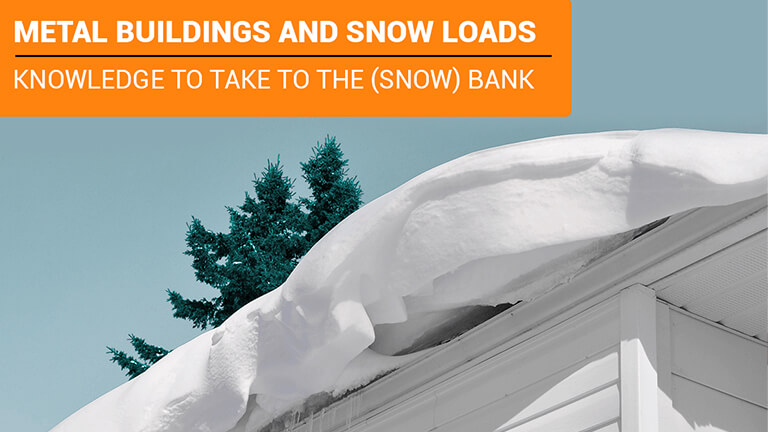Whether you look forward to the first snowfall of the year or you view the winter season with a sense of dread, there’s no debating the tremendous effect the powdery white stuff has on the landscape and your life.
What is easy to overlook is its impact on buildings of all kinds. As the snow accumulates, it exerts more and more force on structures, which can lead to significant damage and even failure. This is where metal buildings come in—they are specifically designed to be the best solution to handle snow loads.
Of course, before we can get into the details of how and why steel buildings are so great for snowy areas, we first have to talk about snow loads!
So, read on to learn about snow loads, steel buildings, and why it’s almost as if they’re made for each other!
What is a Snow Load?
While often light and fluffy in appearance, snow can be quite dangerous as it accumulates and asserts weight on various areas of a building. The technicalities behind these potentially damaging effects typically involve different types of loads (or forces) applied to structures. For a brief explanation of the loads generally at play, see below.
- Dead Loads – Buildings are designed to support their own weight (at least, they should be), right? That’s exactly what dead loads are—a weight that is constant over time. You may know these loads as static as well. Long story short, they’re permanent!
- Live Loads – Contrary to dead loads, live loads are not constant. Instead, they are temporary and caused by something moving. If you walk through your house, you are asserting a live load on the structure.
- Collateral Loads – Like dead loads, collateral loads are (mostly) static. They include anything added to the structure, such as electrical systems, sprinkler systems, or even air conditioning systems. While not technically part of the structure, they are (usually) permanent additions.
- Environmental Loads – True to their name, environmental loads are loads placed on a structure by natural forces. This could be anything from a gentle breeze to a high-intensity earthquake. Snow certainly falls under this category!
What are the Dangers of High Levels of Snow Accumulation?
There are clearly varying degrees of environmental loads. While those degrees are sometimes sudden (a tornado), they can also be gradual (snow accumulation over a season). The key when it comes to the latter is knowing the environmental load limits of your structure.
Excessive snow accumulation is actually one of the biggest threats to structures in the United States. For an example of this, look no further than the winter of 1996-1997, during which the Midwest saw heavier-than-average snowfall. More than 5,000 buildings collapsed that season because the snow accumulation—an environmental load—exceeded the weight-bearing capacity of those buildings.
Metal Buildings for Snow Loads
Every structure has a breaking point, but some are stronger and more durable in the face of high snow loads than others. Metal buildings are specifically designed and engineered to endure such weather events and come out on the other side unscathed. While a tremendous amount of design and engineering goes into these buildings, we’ve chosen a few key features to highlight below.
- Roof Pitch – The pitch or angle of the roof will contribute significantly to shedding snow accumulation and reducing the amount of weight on the steel structure. While it may seem logical that the steeper the angle, the better, there is a sweet spot for metal building roofs. If the roof is too flat, too much snow will accumulate; if the roof is too steep, a dangerous snow slide could occur without warning, causing injury or worse. Roof pitches in snow country should range between 3:12 and 6:12 to perform their best.
- Geometric Features – If discussing roof pitch didn’t emphasize the math and technical design features of steel buildings in relation to snow loads, perhaps talking about geometric features will! Certain geometric designs, especially when incorporated into roofs, are more apt to impede snow shedding or even contribute to snow retention. Sawtooth and stepped roofs are two examples of this, while gable, mono-sloped, and multi-span roofs tend to shed snow more effectively.
- Insulation – Properly insulating your steel building for harsh winters is vital in ensuring it can withstand freezing temperatures and maintain usability year-round. Unlike traditional wooden structures, metal buildings have very deep walls, allowing you to use more insulation. This means more effective, more energy-efficient insulation for your steel building!
- Accessories – When it comes to steel building accessories in areas that see significant snowfall, it’s important to choose wisely. While gutters and drainpipes can facilitate improved runoff, they can also become clogged, frozen, or even get ripped off. On the other hand, roof cleats, snow guards, and other select accessories can facilitate better snow distribution. Talking about your needs with a metal building expert is the best way to ensure you get the accessories you need!
Snow-Worthy Steel Structures from Steel Carports
As the best dealer of metal buildings in the United States, Steel Carports knows about providing high-quality steel buildings for those living in snow country. If you have questions, want to receive a quick and easy quote, or are ready to purchase your dream metal building, call our experts today at (833) 647-8335.

